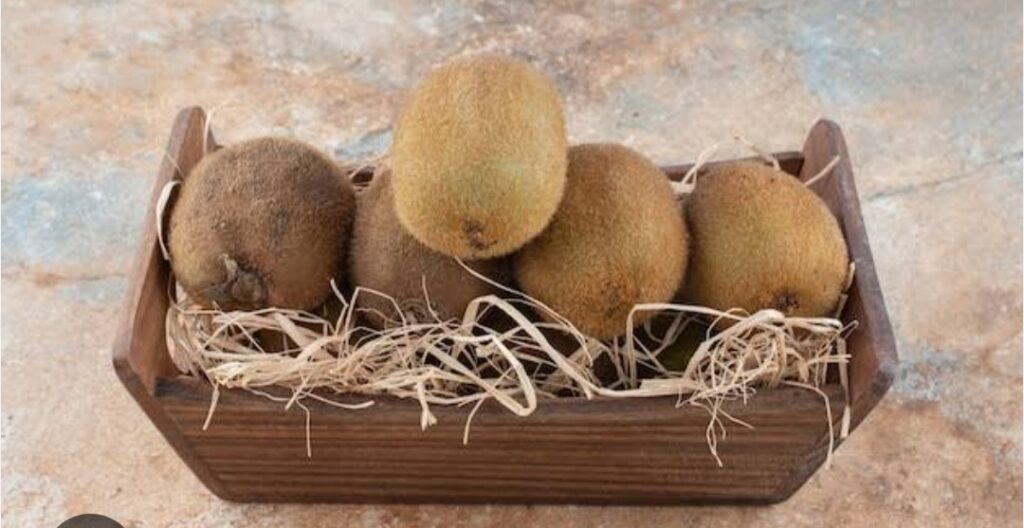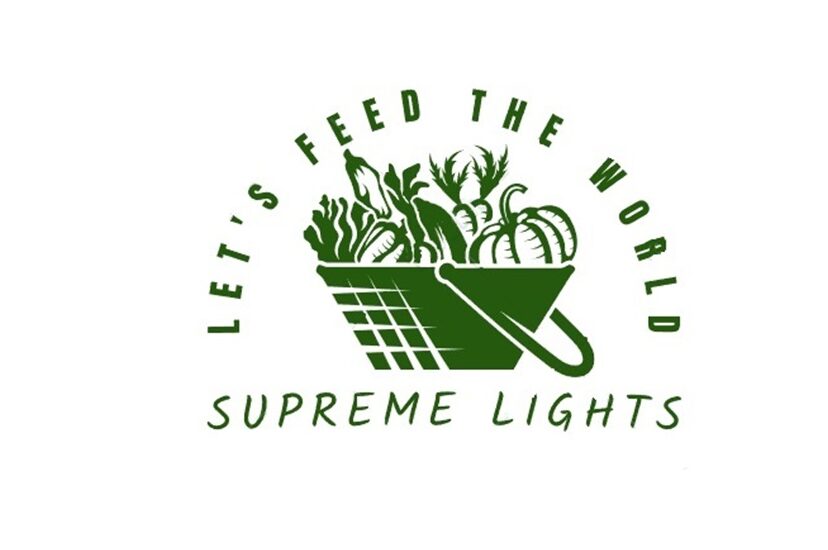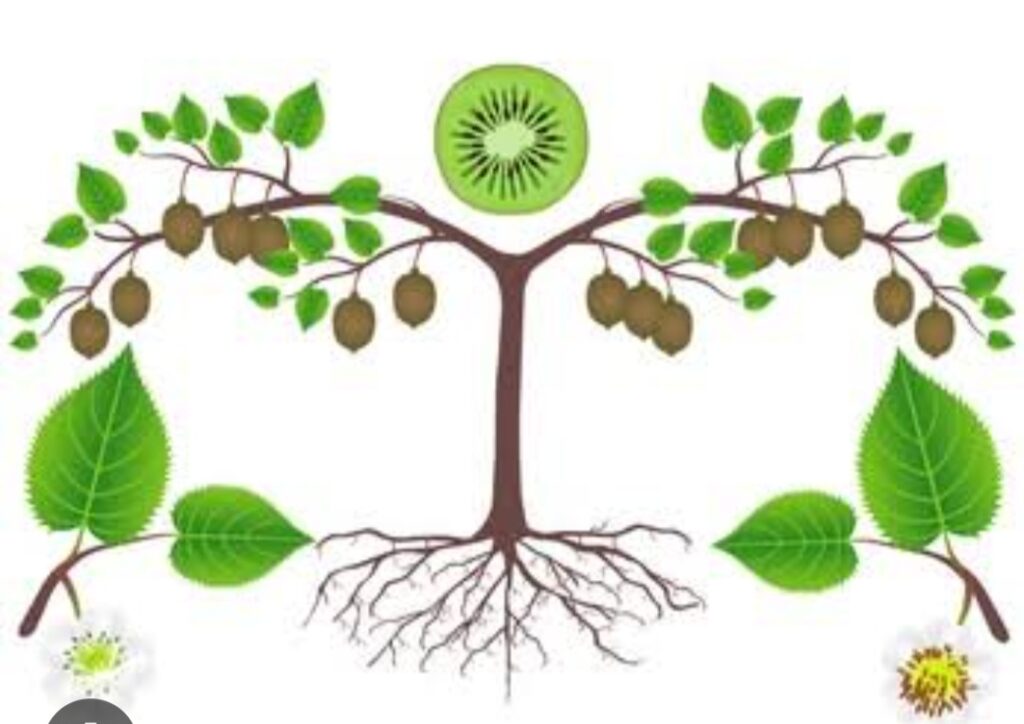
The kiwi plant (Actinidia deliciosa), is a vigorous, woody vine native to China and grown for its edible, fuzzy-skinned fruit, known as kiwifruit or Chinese gooseberry. It belongs to the family Actinidiaceae.
It originate from the mainland China and Taiwan, but also grown commercially in New Zealand and California. The plant produces a fruit, which is a true berry with a fuzzy, brownish-green skin, translucent green flesh, and with numerous edible purple-black seeds.
The Kiwi vines are dioecious, meaning that male and female flowers are borne on separate individuals. They have a
growth habit of producing a climbing vine, making it needs plenty of space and sturdy supports.
PHYSICAL DESCRIPTION
Kiwi plants can reach a height of 9 m (30 ft) and have an economic lifespan of 3 years, after which time fruit production begins to decline.
THE VINES: Kiwi Vines are very aggressive growers. They do not grow quickly. Vines will grow several inches a day at each growing tip. It takes very aggressive pruning to control their size.
The vines are dioecious, meaning that male and female flowers are borne on separate individuals. Generally, one male plant can facilitate the pollination of three to eight female plants.
THE FRUIT: The fruit is ellipsoidal , a true berry and has furry brownish green skin. The firm translucent green flesh has numerous edible purple-black seeds embedded around a white centre.
The fruit has a slightly acid taste and can be eaten raw or cooked. The juice is sometimes used as a meat tenderizer. Raw kiwis are high in vitamins C and K.
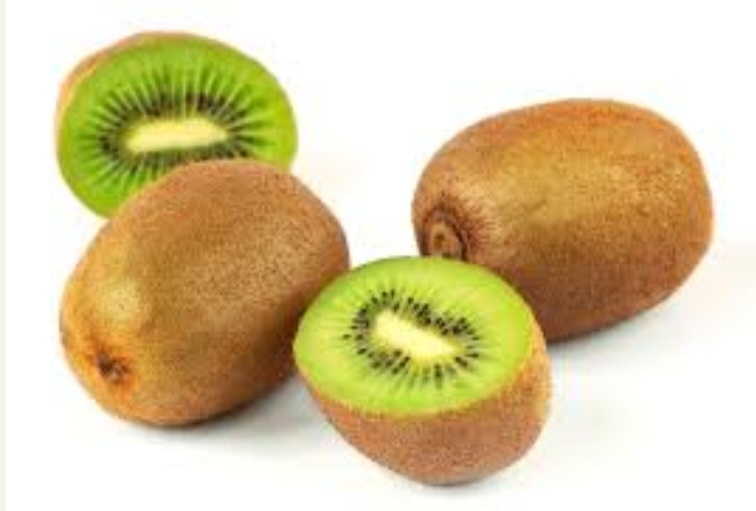
THE LEAVES: The deciduous leaves are borne alternately on long petioles (leaf stems), and young leaves are covered with reddish hairs. While mature leaves are smooth and dark green on the upper surface and white and downy on lower surface.
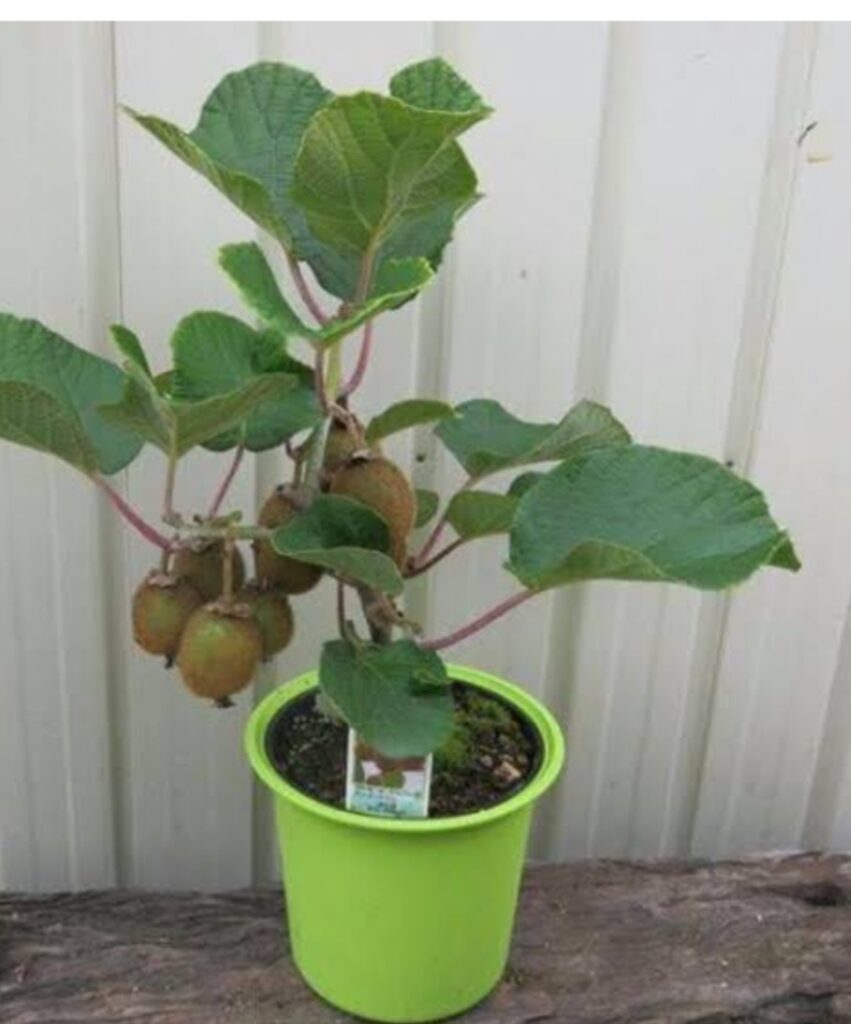
FLOWERS: They produce Fragrant, creamy-white flowers or white-yellow flowers singly or in clusters of 3 at the leaf axils (area between leaf and stem).
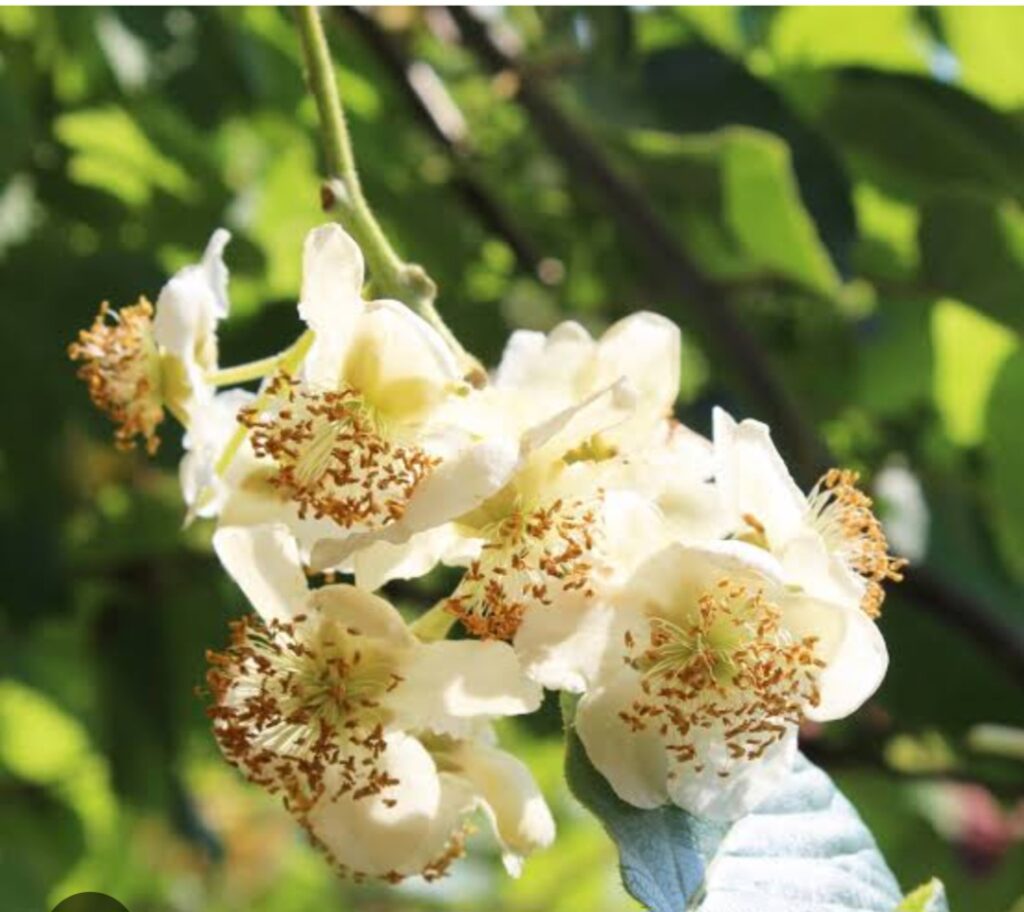
THE ROOTS: Kiwi roots are similar to hop roots in that they get very fat and long very quickly. Therefore, there is need to prune them at least monthly after flowering.
BENEFITS OF KIWI
1. Kiwi fruit offers numerous health benefits, including being a great source of vitamin C, fiber, and antioxidants, which can support heart health, digestion, and immunity.
2. NUTRITIONAL POWERHOUSE THAT SUPPORT THE IMMUNE SYSTEM:
Kiwi is an excellent source of vitamin C, a powerful antioxidant that supports the immune system and helps protect against cell damage.
3. ANTIOXIDANT POWER:
Kiwis contain various antioxidants, including flavonoids and carotenoids, which help combat oxidative stress and inflammation in the body.
4. OTHER NUTRIENTS:
Kiwi also provides potassium, vitamin E, vitamin K, and folate, further contributing to overall health.
5. HEART HEALTH:
The fiber, potassium, and antioxidants in kiwis may contribute to a healthy heart by helping to lower blood pressure and cholesterol levels. This makes kiwi fruit important because cardiovascular health is linked to sexual function.
6. DIGESTIVE HEALTH:
The fiber content in kiwis can promote regular bowel movements and alleviate constipation.
7. IMMUNE SUPPORT:
Vitamin C and other nutrients in kiwis can help boost the immune system and protect against infections, making it a contributor to overall health and potentially prevent sexual dysfunction.
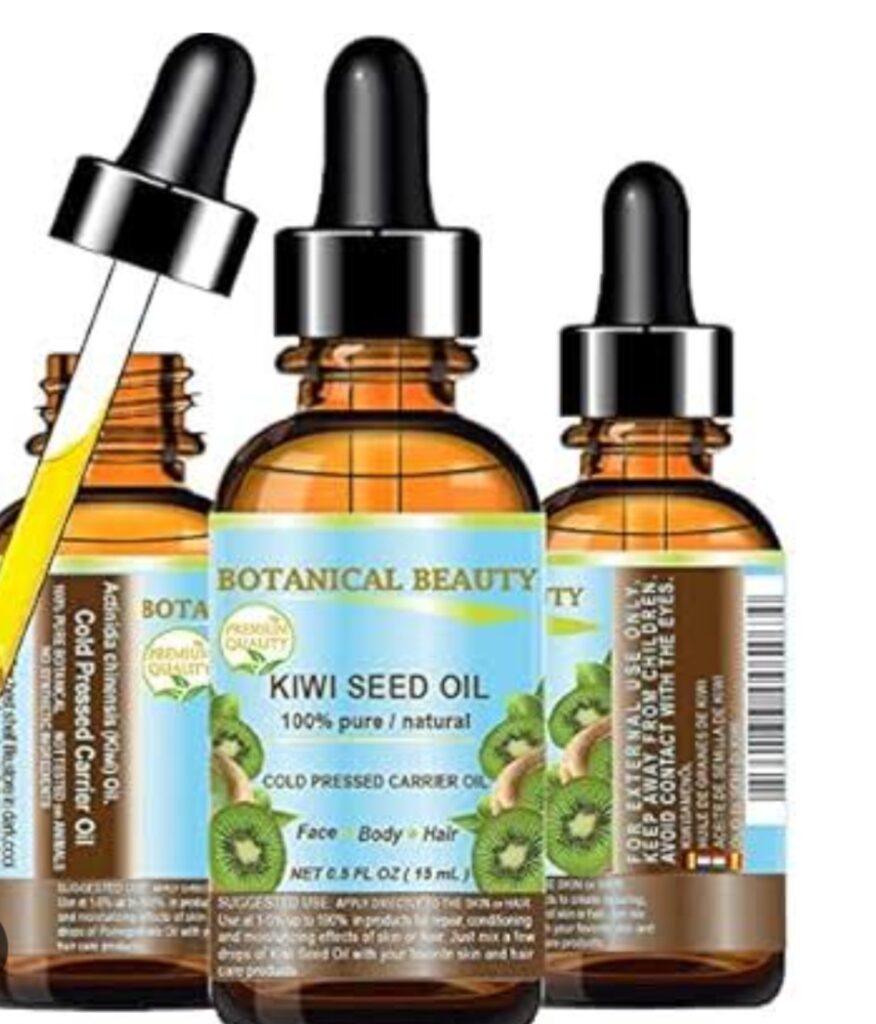
8. EYE HEALTH:
Kiwis contain antioxidants that may help protect against age-related eye diseases, such as macular degeneration.
9. SKIN HEALTH:
Vitamin C and antioxidants in kiwis can contribute to healthy skin by protecting against damage from free radicals and promoting collagen production.
10. SLEEP QUALITY:
Some studies suggest that kiwis may improve sleep quality, potentially due to their serotonin content.
11. ASTHMA SYMPTOMS:
The high vitamin C and antioxidant content in kiwi can help reduce asthma symptoms, such as wheezing and shortness of breath.
12. Kiwi, rich in vitamin C and antioxidants, may support sexual health by promoting blood vessel health, potentially reducing erectile dysfunction risk, and enhancing sperm health.
13. IMPROVED SPERM HEALTH:
Kiwi’s antioxidants, including vitamin C and vitamin E, can help reduce oxidative stress, protect sperm DNA, and potentially improve sperm motility.
14. BLOOD VESSEL HEALTH:
Vitamin C, abundant in kiwi, supports healthy blood vessels, which is important for maintaining blood flow and potentially reducing the risk of erectile dysfunction.
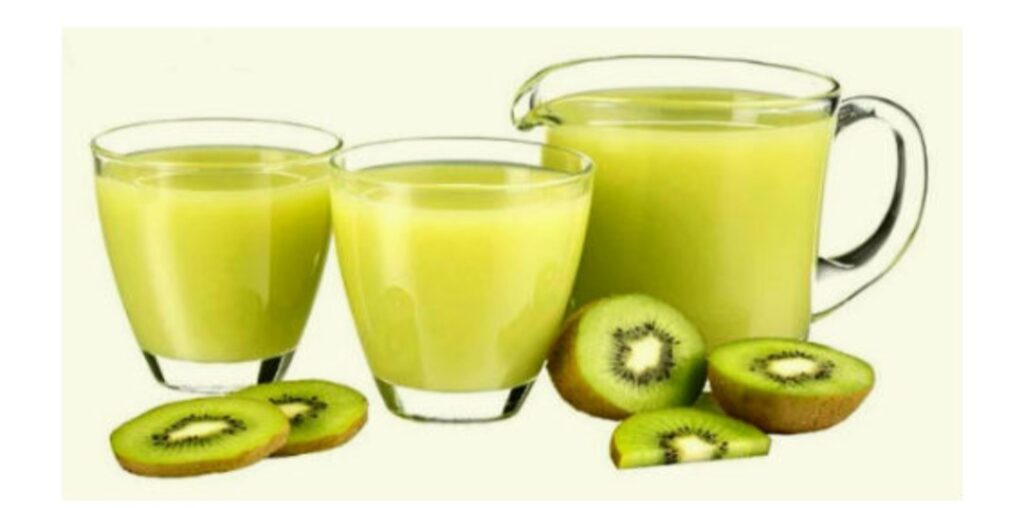
15. ANTIOXIDANT POWER:
Kiwi’s antioxidants can help combat free radicals, which can damage cells and contribute to various health problems, including those affecting sexual function.
16. IMPROVE SLEEP: Eating kiwis before bed might help improve sleep quality, which in turn can positively impact sexual function.
17. GUT HEALTH: Kiwi’s fiber content can support gut health, which is important for overall well-being.
18. FIBER BOOST:
Kiwis are a good source of both soluble and insoluble fiber, which aids in digestion, promotes healthy gut bacteria, and can help regulate blood sugar levels.
19. They are delicious, easy to eat, and incredibly healthy.
20. Green slices with black seeds of kiwi fruit have long been used to spruce desserts and fruit bowls. The unique appearance and high nutritional value of kiwi set it apart from other fruits, and they add a brilliant pop of colour to any dish. It also has refreshing flavour, making it a popular fruit option.
21. KIWI’S NUTRITIONAL VALUE
This is the nutrient breakdown for a 3.5 ounce (100gm) portion of the flesh of a raw, green kiwi:
Carbs: 14 gms
Calories: 64
Fat: 0.44 gms
Fiber: 3 gms
Protein: 1 gm
Vitamin C: 83 percent of the Daily Value (DV)
Vitamin K: 34 percent of the DV
Vitamin E: 9 percent of the DV
Copper: 15 percent of the DV
Folate: 7 percent of the DV
Magnesium: 4 percent of the DV
Potassium: 4 percent of the DV
22. In Mal human, Kiwi benefits the sexuality of male human being in many ways, some of which are as follows.
a. KIWI FRUIT FOR MALE FERTILITY:
It is rich in vitamin E and C compared to other fruits that people usually eat. One cup has about 20% of recommended daily amount of Vitamin E and more than 2000% of the recommended daily amount of vitamin C.
These two vitamins improve sperm motility and count when taken independently, but their benefits are even more remarkable when taken together.
b. Both vitamins E and C in kiwi are antioxidants in food, but they do not work the same way. They each target and reduce harmful free radicals, making them work together to reduce inflammation in different and unique ways.
c. A study shows that vitamins C and E, when taken together, can help improve semen parameters.
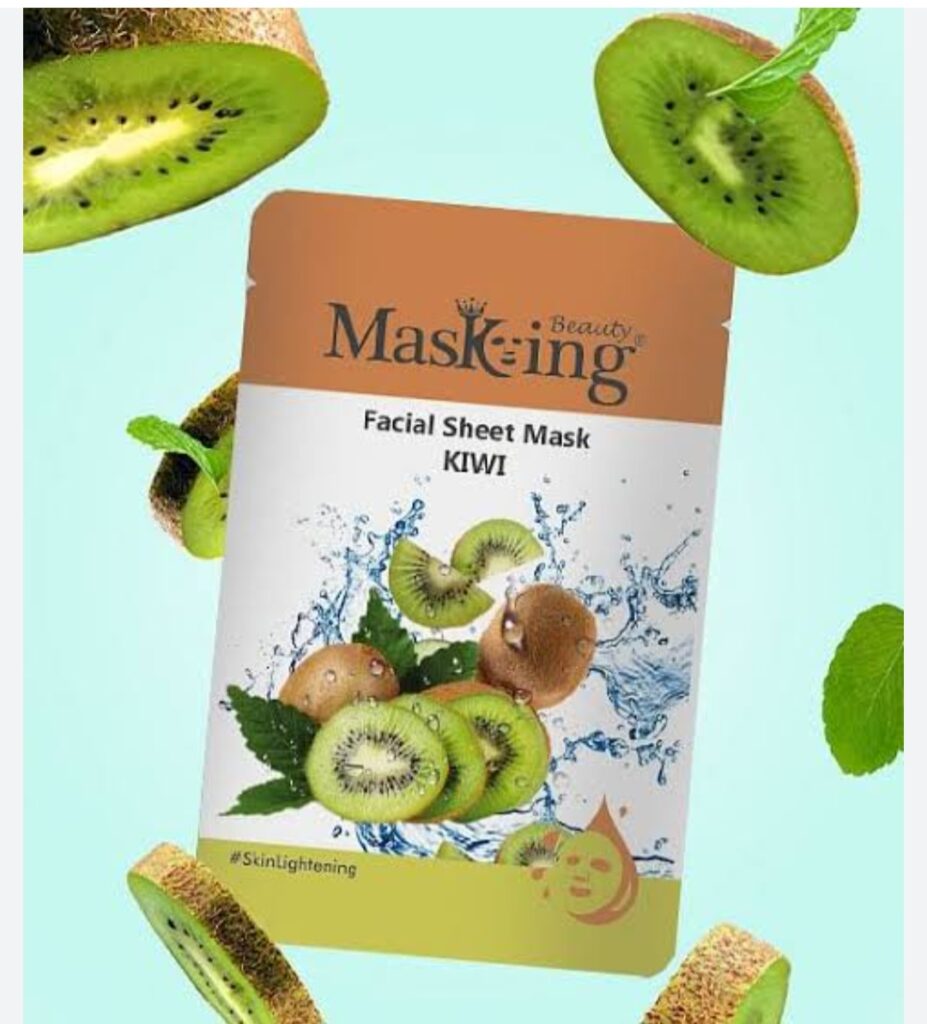
23. ZINC FOR MALE;
Zinc is present in abundance in kiwi fruit. Zinc has a significant impact on a man’s ability to conceive, and zinc’s antioxidant qualities prevent the cells from the harmful effect of free radicals. A study found that males with greater zinc levels had more sperm and better sperm quality. If a male human has more sperm and better quality, he may be more likely to conceive children.
24. INCREASE LIBIDO:
One of the surprising kiwi benefits for males is to improve their sex drive. Testosterone levels are clinically shown to rise when men take vitamin C, resulting in increased sexual desire. Testosterone has long been famous for being the primary catalyst for male sexual desire.
Vitamin C, which is a potent antioxidant, increases nitric oxide synthesis (NO). Increasing a man’s sex drive is possible since nitric oxide plays a significant part in his sexual ability.
25. FIGHT THE SIDE EFFECTS OF TADALAFIL
Research on rats indicated that kiwi fruit was advantageous and might counteract the adverse effects of tadalafil, a common medication for E.D, due to the Vitamin C levels in kiwis, which is higher than in oranges.
Despite all kiwi benefits for males, it is best to consult a Specialist rather than using it on its own if concerned about ones sexual health.
26. Besides kiwi benefits for males, it is also great for females, especially for boosting fertility. It has a low G.I. and is low in fat and abundant in folic acid. Women who want to start a family should adopt a healthy lifestyle by eating low G.I. carbs, balanced proteins, and low-fat foods.
27. Kiwi is also beneficial too at night. Eating 1–2 medium kiwis before going to bed will make one to fall asleep faster and stay asleep longer. It may be better to eat a kiwi before going to bed because it has a lot of serotonin and antioxidants, which may help induce sleep better.
28. Kiwi is also beneficial for Skin. The antioxidant, moisturizing, rejuvenating, and skin-soothing properties are excellent, making it beneficial for males and females. It is also present in cosmetic products, lotions, and creams.
29. Kiwi Fruit is beneficial for Weight Loss. It is low in calories and has a lot of fiber, protein, digestive enzymes, and vitamin C, which can help lose weight. A diet high in fiber from fruits and vegetables has been shown to help people lose weight, feel fuller, and have a healthy gut.
30. Kiwi seeds also has its Benefits.
a. In kiwifruit, there are tiny black seeds that can be eaten. b. The seeds have a lot of essential nutrients, even if they are only there in small amounts.
c. Kiwi seeds have a considerable amount of omega-3 fats, and Omega-3 fats are suitable for the brain and heart.
31. It is adviceable to take 2 to 3 Kiwis every day because they help thin the blood. A healthy blood flow also improves sex life, which means males will have stronger erections and more powerful orgasms.
32. Eating kiwi every day helps
Keep blood pressure in check and boost Vitamin C intake.
33. kiwi can help avoid strokes and heart disease.
34. Kiwis are great for boosting energy and are especially good before and after a workout. Refueling the body with them after work out is excellent.
35. Kiwis are primarily consumed as a fresh fruit.
Important Notice:
While kiwi offers potential benefits, it’s important to remember that a balanced and healthy lifestyle is crucial for overall sexual health.
DISADVANTAGES OF KIWI FRUIT
1. The most common disadvantages of kiwi fruit are different kinds of allergy reactions.
People who are allergic to kiwi can have troubles like swallowing, vomiting, and hives when they eat the fruit.
2. It result in some illnesses such as ; Dermatitis,
Pancreatitis, Latex Allergy,
Oral Allergy Syndrome (OAS), etc.
3. Raw kiwifruit is rich in a protein-dissolving enzyme called actinidain. This makes the kiwi unsuitable for use in dishes that contain milk products or gelatin. If these dishes are not served immediately, the enzyme starts to digest the proteins in the dishes, destroying the texture. In gelatin-based dishes, the enzyme can prevent the liquid from solidifying.
TYPES AND VARIETIES
There are two main types of Kiwifruit plants grown in home gardens: Kiwifruit and Kiwiberry. Both types of kiwi are frost-susceptible, so this plant is best grown in areas with a frost-free growing season of at least 200 days.

KIWIBERRY (Acinidia arguta) Kiwiberry produces a smooth, green, grape-sized fruit. They are grown often for their attractive, pink-variegated foliage and fragrant flowers. Native to northern China, Japan, and Korea, this exported plant is sometimes called “hardy kiwi” or “Northern kiwi.” It is also known by other names such as baby kiwi, dessert kiwi, grape kiwi, and cocktail kiwi.
As the name suggests, the hardy kiwi (Actinidia Arguta) does best in colder areas (USDA zones 4 to 7) and can even survive subzero temperatures.
The plant comes in several varieties. The varieties include;
Hayward’ is the main female variety of A. deliciosa grown commercially. It produces the fuzzy brown fruit with green interiors that can be found in grocery stores.
Male varieties include ‘Chico’, ‘Matua’, and ‘Tamori’.
A. arguta ‘Ananasnaya’ (also called ‘Anna’) has jade-coloured skin, bright green flesh, black seeds and tastes like pineapple.
A. arguta ‘Issai’ is self-fertile (does not require a male pollinator) and produces small, juicy fruit. Pollinators love the fragrant white flowers in early summer.
A. arguta ‘Geneva’ ripens earlier than either ‘Anna’ or ‘Issai’ and has sweet, honey-flavoured fruit.
A. arguta ‘Ken’s Red’ has fruit with reddish-purple skins. The flesh inside is dark green with deep-red streaks.
A. kolomikta ‘Red Beauty’ fruit ripens earlier than most hardy kiwi species, but A. kolomikta can be more temperamental in general. Its fruit is skinny and sweet. Foliage turns a brilliant red in the fall.
Note: If you are considering growing kiwifruit in the garden, know that both a male and a female plant are required to produce fruit. The male plant produces flowers, while the female plant produces both flowers and fruit. (However, one reportedly self-fertile variety of hardy kiwi is called ‘Issai’ it requires only a space for one plant)
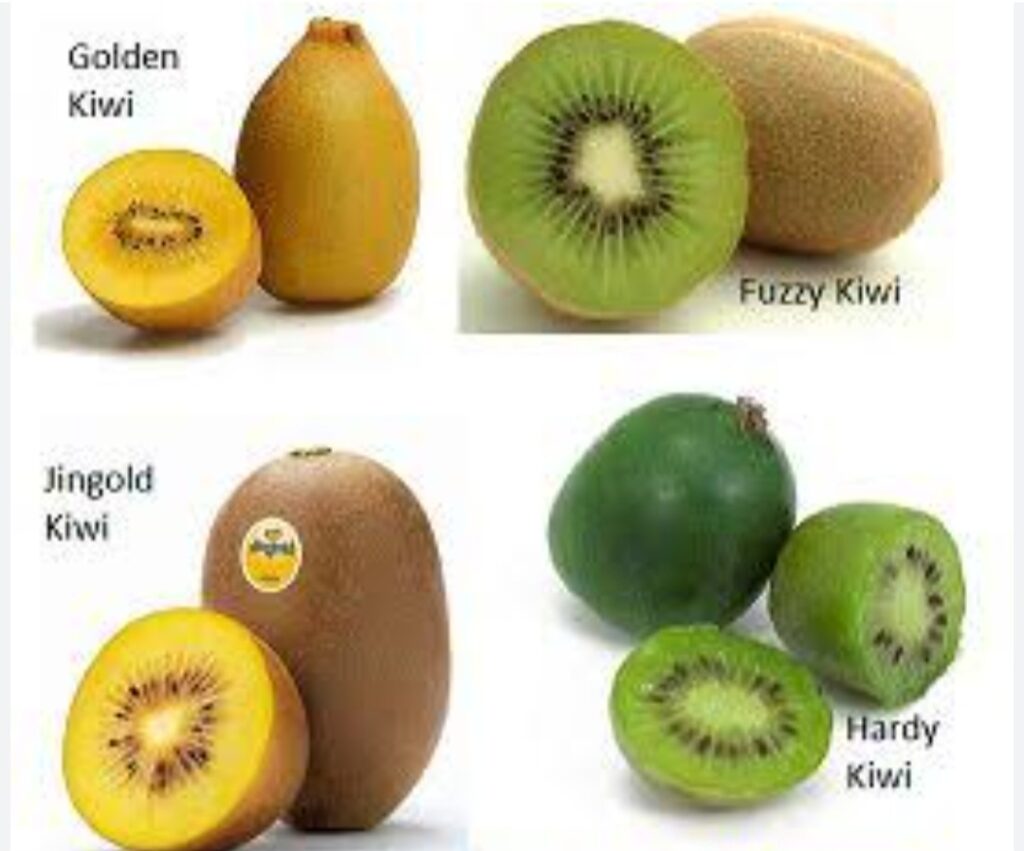
CLIMATIC REQUIREMENT
Kiwi plants are native to warm, forest regions of China and require a long growing season with 8 to 9 month with no frost.
a. TEMPERATURE REQUIREMENTS: The optimal temperature during the growing season is between 14 and 24°C (57.2–75.2°F). The plant can tolerate cold but is damaged by temperatures below -8°C (17.6°F). Some varieties such as the Hayward cultivar will tolerate temperatures down to -10°C (14°F). Kiwi should be planted in full sunlight to ensure optimal productivity.
SOIL REQUIREMENT: kiwifruit vines will grow best when planted in deep, well-draining, sandy loams soil because they are extremely sensitive to standing water. Apart from which they are also prone to root rot if kept too wet.
The optimum pH for the soil should be between 5.5 and 6.0.
PLANTING
Kiwi Vines can be planted in the spring after the threat of frost has passed. It will start bearing fruit between 3 to 5 years after planting.
To get a good crop from kiwi, a male plant and female plants are required. The females produce the fruit. The best ratio is at least one male plant for every six female plants.
Plant the vines 10 to 15 feet apart.
IDENTIFICATION OF MALE AND FEMALE KIWI VINES
Kiwi plants are dioecious, which means that the plants only have female or male parts. So in order to produce fruit both must be present.
Both male and female vine can only be identified when the male or female vine is at bloom time. Female kiwis have multi-branched stigmas in the center of the flowers with a row of white ovules at the base of the flower, which will develop into a seed when fertilized. The male vines have lots of stamens with anthers that are covered in pollen.
It is recommended that one male plant be present for every six females.
PLANTING SITE
Kiwi vines need a sunny spot for the best growth and fruit production.
The areas should be protected to avoid wind damage. The vines should be planted at the north side of the yard in colder regions to minimize the risk of freeze-thaw damage in early spring, when plants are especially susceptible.
PROPAGATION OF KIWI VINES
Kiwis can be propagated both sexually and asexually. Various varietal methods are involved, including growing from seed or from hard or softwood cuttings or root cuttings. The easiest method of propagation is the use of softwood cuttings.

Kiwi can be propagated from seeds by planting in nursery after which they are transplanted.
The seeds should be planted 1/8 inch deep in moist sterile potting mix or trays and covered with plastic wrap.
The container or trays should be placed in a warm, bright spot and the soil moistened.
When the seedlings start emerging, uncover the container.
When the plants have four true leaves, the seedlings should be transplanted into individual plastic nursery bags.
When the plants are several inches tall, they should then be transplanted outdoor.
ASEXUAL PROPAGATION
Apart from sexual propagation, kiwi can also be propagated asexually. In asexual propagation,
Kiwis can be propagated from softwood cuttings (cuttings taken from new growth during the summer). The cuttings should be taken during the summer months when the tree is actively growing. Each cutting should be taken from the current season’s growth and should possess 2-3 nodes (leaves). The leaves must be fully expanded in order for the cutting to be successful. Cuttings should not be taken from immature growth such as at the end of shoots. Once the cuttings have been obtained, they should be stripped of all but the top-most leaf. Rooting hormone can be used to aid the cuttings in developing new roots. Those containing indole-3-butyric acid have been shown to be most effective in kiwi propagation. After treatment with rooting hormone, the kiwi cuttings should be planted in beds or small pots, preferably in a glasshouse, and kept moist. When the cuttings have began to develop new shoots, they should be transferred into 1 gallon pots or planting bags containing a high quality potting soil and watered daily. The potted plants should be fed with a slow release fertilizer at least twice over the growing season
Apart from planting the cuttings in a soil medium, they can also be raised using soil less method. The process is as follows;
Cut a kiwi stem into six-inch lengths and cut off any growing tip. The cuttings should then be put into a glass with an inch of water.
In about three weeks, the cuttings will have tiny roots at the ends of the cuttings.
Plant the cuttings in pots or plant outdoors.
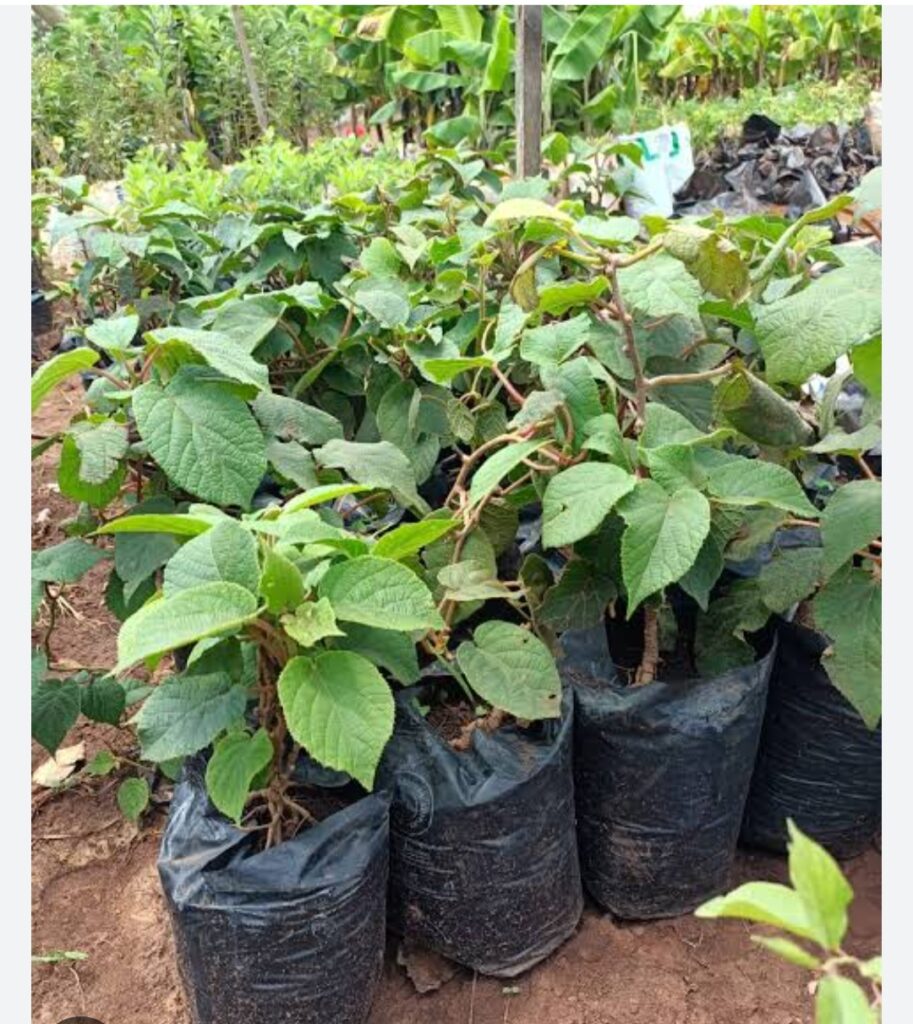
WATER OR IRRIGATION: kiwifruits require a plentiful supply of water during production
TRANSPLANTING: If the kiwi vines are to be grown on a trellis or pergola, this should be constructed prior to planting. Kiwi should be planted by digging a planting hole which is at least three times the width of the current pot that the plant is in. The vines should be wounded around the legs of the trellis to climb and produce fruits. SPACING: Individual plants should be spaced at 5 m (16.4 ft) apart when using a T-trellis system but can be planted closer together when vines are managed by pruning. Approximately 6 m (19.6 ft) should be left between rows. This distance is again dependent on the training system being utilized. Almost all kiwi species are dioecious and require the presence of both a male and female tree in order to set fruit. The recommended planting ratio is 1 male to every 8 females but a higher density of male trees will increase productivity.
TRAILLIS: Kiwi plant produces vines that require the support of a trellis to support the weight of the growing fruit. The vines are also slow growers and need sturdy supports.
Erect a tall, heavy-duty trellis system that can support the vines that can grow 15 feet wide and 20 feet long, and produce up to 100 pounds of fruit.
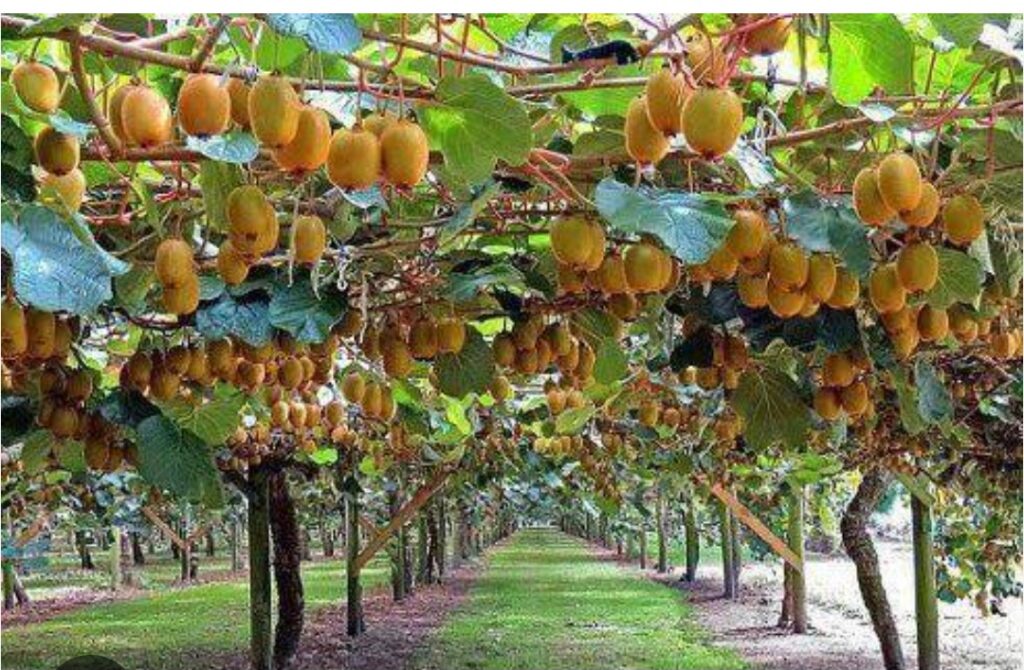
PRUNNING
Start training the flexible vines up a support during the first year of planting.
Prune the lateral growth (if not flowering) 2 to 3 times during the growing season.
Kiwi plants flower and fruit on old wood. Regularly remove water sprouts (vigorous shoots originating from older wood) and shoots from the trunk.
Prune female vines during the winter months, when the plant is dormant. Prune male vines in early summer after bloom.
In cold areas, the vines of hardy kiwi may die back to the ground each year. Remove the dead stems and mulch with leaves or straw.
ROOT TRIMMING
When planting, there may be need to trim the roots if too long. The vines must be planted deep enough to cover the roots well with soil.
FERTILIZER REQUIREMENT: Kiwis have a high nutrient demand, particularly for nitrogen and potassium. after the first year of planting, plants should be fertilized in the Spring and as required throughout the growing season with the type and amount of fertilizer depending on the particular soil type and the age of the vines.
Note: Do not fertilize in the first year after planting. After the first year after planting, fertilize with a well-balanced fertilizer or soybean meal in the spring.
COMMON PESTS AND DISEASES OF KIWI
DISEASES
Some of the diseases that affect kiwi plant include; Fungal, Bacterial, Oomycete, root rot, etc
FUNGAL
Armillaria root rot is caused by the fungi Armillaria mellea.
Root rot can occur if plants become waterlogged.
Phytophthora crown rot and
Wit can affect the production of kiwi plant.
SYMPTOMS
Vines may completely collapse, white mycelial mats may be present under bark close to the soil line. Cortical tissue has a dark discoloration and white mycelial strands are present, root-like rhizomorphs extend from roots into soil
The disease emergence is favoured by continually damp soil, or saturated soils.
CONTROL
a. Ensure that land to be used for new kiwi plantings is completely cleared of roots which are greater than 1 inch in diameter
b. Ensure kiwi vines are adequately irrigated but not overwatered
2. BACTERIAL
A. Bacterial blight. The disease is caused by the bacteria Pseudomonas spp.
SYMPTOMS
Brown, sunken lesions on petals covering flower buds, yellow-orange discoloration of petals. Small yellow spots may appear on leaves after periods of rain.
The bacteria enter the plants through wounds
CONTROL
a. Control of the disease relies on the avoidance of injuries to the plant which allow bacteria to enter.
b. There are currently no recommended chemical control strategies for the disease
B. Bleeding canker It is caused by a bacteria called Pseudomonas syringae
SYMPTOMS
Wilting plants, blighting of canes, red, rust coloured cankers on branches which may exude red coloured discharge
The disease has a wide host range.
CONTROL
a. Infected areas should be pruned by cutting 1 foot below the edge of the canker.
b. The disease severity can be reduced by protecting plants from freeze injuries over winter
C. CROWN GALL
This disease is caused by a bacteria called Agrobacterium tumefaciens
SYMPTOMS
Reduced plant vigor, leaves are smaller in size, poor growth, open canopy, reduced yield and galls may be too small to see.
The bacteria enter the plant through wounds.
CONTROL
a. Control of the disease relies on the avoidance of injury to kiwi vines.
b. Existing galls can be surgically removed
3. OOMYCETE
A. Phytophthora root and crown rot
These two diseases are caused by Phytophthora spp.
SYMPTOMS
Reduced shoot growth, small, chlorotic leaves are formed. Vines may collapse suddenly or show a gradual decline in productivity over several seasons, red-brown discoloration of roots and root crowns which is visible when root is cut in two
Disease emergence is favoured by poorly drained soils and flood irrigation
CONTROL
a. Control of the disease is reliant on good water management and application of appropriate fungicides.
b. Kiwi should be planted in well-draining soils where water does not pool after rain or irrigation.
c. Plants should be allowed to dry out between irrigations
HARVESTING
The fruit typically reaches maturity in September/October, which can make it susceptible to early fall frosts in some areas.
Harvest the fruit when they are soft to the touch and ready to be eaten.
Alternatively, if early fall frosts are a concern, harvest kiwi fruits when they are still firm but have black seeds. This fruit can be stored in the refrigerator for up to six weeks. Remove it from the refrigerator and allow it to soften for a couple of days before eating.
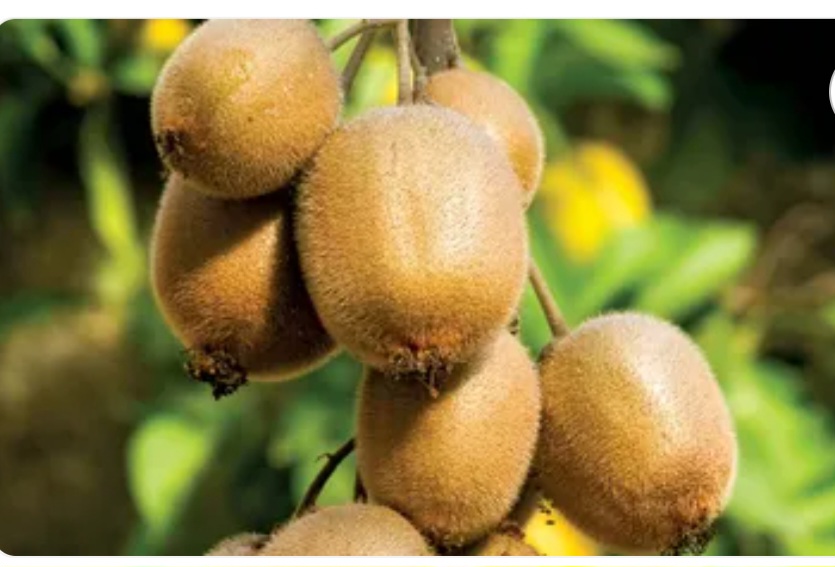
STORAGE OF KIWI FRUIT
Store firm kiwi in the refrigerator or a cooler for up to six weeks.
Freeze firm whole hardy kiwis on a cookie sheet and then put them into plastic freezer bags.
